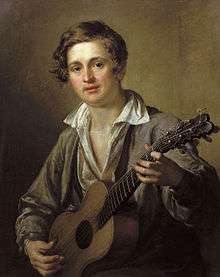Romance (music)

The term romance (Spanish: romance/romanza, Italian: romanza, German: Romanze, French: romance, Russian: романс, Portuguese: romance, Romanian: romanţă) has a centuries-long history. Applied to narrative ballads in Spain, it came to be used by the 18th century for simple lyrical pieces not only for voice, but also for instruments alone. The Oxford Dictionary of Music[1] states that "generally it implies a specially personal or tender quality".
Instrumental music bearing the title "Romance"
Typically, a Classical piece or movement called a "Romance" is in triple rhythm, with three beats in the bar.
- Beethoven: two violin romances (Romanzen) for violin and orchestra, No. 1 G major, Op. 40; No. 2 in F major, Op. 50 take the form of a loose theme and variations.
- Johannes Brahms: Romanze in F major for piano, Op. 118, No. 5 (1893)
- Max Bruch: "Romance for Viola and Orchestra in F"
- Antonín Dvořák: Romance in F minor for violin and orchestra, Op. 11 (1873/1877)
- Edward Elgar: Romance for bassoon and orchestra, Op. 62 (1910)
- Edvard Grieg: String Quartet No. 1 in G minor, Op. 27 (1878), second movement
- Wolfgang Amadeus Mozart: Romanze from Eine Kleine Nachtmusik, the second movement; Piano Concerto No. 20, second movement
- Joseph Haydn: "Romance: Allegretto" from Symphony No. 85 in B♭, "La Reine," the second movement
- Camille Saint-Saëns: Romance in D for violoncello and orchestra, Op. 51 (1877)
- Clara Schumann: Drei Romanzen for violin and piano, Op. 22 (1853)
- Robert Schumann: Drei Romanzen (for piano), Op. 28. (1839)
- Robert Schumann: Drei Romanzen (for oboe or violin and piano), Op. 94. (1849)
- Dmitri Shostakovich: Romance from The Gadfly Suite
- Jean Sibelius: Romances for piano Op 24, No. 9, Op. 78, No. 2
- Johan Svendsen: Romance for violin and orchestra, Op. 26 (1881)
- Ralph Vaughan Williams: Romanza, in his Concerto in F minor for bass tuba, No. 2 (1954)
- Anonymous: "Romance/Romanza" for the classical guitar, known variously as Spanish Romance, Romance D'Amour, etc.
Mozart subtitled the second movement of his piano concerto no. 20 in D minor (K.466) "Romanze" and his Horn Concerto has a Romance and Rondo.
Robert Schumann was particularly fond of the title for lyrical piano pieces.
Georges Bizet's "Je crois entendre encore" from The Pearl Fishers (1863) is labelled a romance in the score.
Giuseppe Verdi's "Celeste Aida" from Aida (1871) is labelled romanza.
Lieder
Lieder by Franz Schubert:
- D 114, "Romanze" ['Ein Fräulein klagt’ im finstern Turm'] for voice and piano (1814; 2 versions)
- D 144, "Romanze" ['In der Väter Hallen ruhte'] for voice and piano (1816, sketch)
- D 222, "Lieb Minna" ['Schwüler Hauch weht mir herüber'] for voice and piano (1815, also appears as "Lieb Minna. Romanze")
- D 907, "Romanze des Richard Löwenherz" ['Großer Taten tat der Ritter fern im heiligen Lande viel'] for voice and piano (1826?, two versions, 2nd version is Op. 86)
Also No. 3b of Schubert's Rosamunde is a "Romanze."
Romances sans paroles
So many composers in the French tradition wrote Romances sans paroles, "Romances without words", from the 1840s onwards[2] that the radical poet Paul Verlaine in turn published a collection of his impressionistic poems as Romances sans paroles (1874).
Russian romance
During the 19th century Alexander Alyabyev (1787-1851), Alexander Varlamov (1801-48) and Alexander Gurilyov (1803–58) developed the French variety of the romance as a sentimental category of Russian art song. Black Eyes is perhaps the best known example. Among other notable examples of the Russian Romance are Shine, Shine, My Star and Along the Long Road.
British singer Marc Almond is the only Western artist to receive acclaim in Western Europe as well as in Russia for singing English versions of Russian romances and Russian chanson on his albums Heart on Snow and Orpheus in Exile.
Notes
- ↑ The Oxford Dictionary of Music, Michael Kennedy, editor, 1985 (New York City: Oxford University Press), sub "Romance".
- ↑ Sigismond Thalberg, Henri Vieuxtemps, Gabriel Fauré, Camille Saint-Saëns, Georges Bizet, Alexandre Guilmant, Alexander Dreyschock, Cécile Chaminade, Zygmunt Stojowski
References
- (in French) Henri Gougelot, La Romance française sous la Révolution et l'Empire : choix de textes musicaux (Melun:Legrand & Fils, 1937) [2nd ed., 1943].
- (in French) Henri Gougelot, Catalogue des romances françaises parues sous la Révolution et l'Empire, les recueils de romances (Melun:Legrand & Fils, 1937)
- Russian romances on YouTube
External links
- Jean-Luc Perrot plays the Romance from l’Art du facteur d’orgues, Dom Bedos de Celles on the organ François-Henri Clicquot, Souvigny
- Romances at The LiederNet Archive